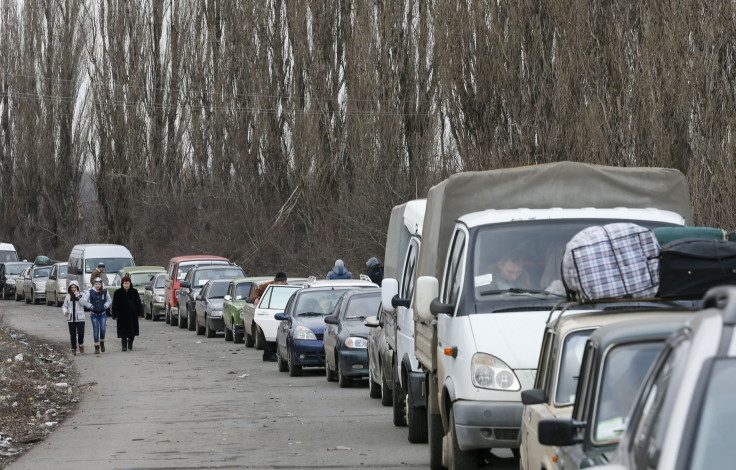Ukraine-Russia Border Traffic: Ceasefire Causing More Ukrainians To Return Than Flee, OSCE Says

The trend of border traffic flowing from Ukraine into Russia has reversed, with more people flowing back into Ukraine over the past two weeks, according to the Organization for Security and Cooperation in Europe, which monitors border traffic there. The reversal may be attributed to the ceasefire between the Ukrainian government and pro-Russian separatists that has de-escalated the conflict that led thousands of eastern Ukrainians to flee to Russia during the past year.
When fighting was heavy, up until mid-February, hundreds more people were crossing from Ukraine to Russia every week. A tenuous Feb. 15 ceasefire appears to have reversed that. The OSCE’s latest report said that 289 more people returned to Ukraine than fled the torn country. The net flow change “confirms the clear reverse flow in the cross-border movement mentioned in the previous two weeks since the 15 February ceasefire,” an OSCE news release said.
The OSCE monitors the Donetsk Border Cross Point (BCP) and the Gukovo BCP, which account for roughly 30 percent of all traffic from Ukraine to Rostov, the bordering Russian oblast, or province. The net flow is measured by subtracting the total number of people who go from Ukraine to Russia with the number of people going the opposite way. The OSCE calls a positive flow from Ukraine to Russia a “plus” flow and a positive flow from Russia to Ukraine as a “minus” flow. For example, if the flow was plus 10 per day, it would mean that 10 more people traveled from Ukraine to Russia on average per day.
Observers first recorded a reversal in traffic toward Ukraine on Feb. 16 at the Donetsk BCP. The Donetsk BCP accounts for about twice as much traffic flow as the Gukovo BCP, which from Feb. 11-18 still saw a diminishing, but still positive, flow toward Russia.
Fighting raged in the days following the supposed ceasefire as rebels sought to take back land they argued was rightfully theirs, but people returned regardless. The ceasefire was agreed upon Feb. 12 and Ukrainian refugees began moving back after hearing of the planned ceasefire.
Both border crossings saw the net flow average reverse toward Ukraine from Feb. 18-25, up to a minus 184 per-day flow. Even more people traveled to Ukraine last week as the net flow jump to minus 289 between both Donetsk and Gukovo BCPs, “confirming a clear reversal of the movement trends at the border,” that had been observed in the weeks following the ceasefire.
In all, more than 2,000 people returned to Ukraine between Feb. 18-25 at the two BCPs, most of which crossed at the Donetsk BCP. Observers saw a number of what appeared to be charter buses taking people across the border, a common occurrence there. Similar buses were often seen picking up fleeing civilians in towns and cities ravaged by artillery fire and fighting.
While fighting has calmed, it has not completely stopped in eastern Ukraine. Few Ukrainian soldiers have been killed in recent weeks, but analysts worry that a ceasefire provision to withdraw heavy artillery has not yet been fully implemented. Artillery and other long-distance weapons have accounted for around 60 percent of all Ukrainian military casualties. More than 6,000 people have been killed in the fighting, according to the United Nations.
© Copyright IBTimes 2024. All rights reserved.






















